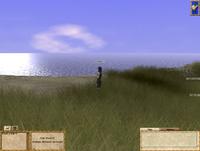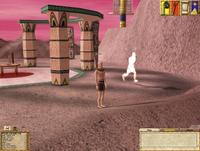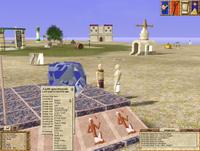|
|
|
Main News Forums Games Games Database Top 100 Release List Support Files Features Reviews Previews Interviews Editorials Diaries Misc Download Gallery Music Screenshots Videos Miscellaneous Staff Members Privacy Statement |
A Tale in the Desert: Status Report #2 It's Sunday today (the day I wrote this article). For us, Sunday usually means slow news and little activity. It's the time when developers and PR people alike are recovering from their stressful week. Not for Andrew Tepper, lead designer of A Tale in the Desert (ATITD). He's currently busy coding for the game and just minutes ago he was still giving a tour to one of those annoying journalists. Me. The first telling of eGenesis' most extraordinary MMOG A Tale in the Desert is now well underway, having been up for about seven months. Following our previous Status Report Q&A #1, we now present you with an even more detailed update on the game's status, as Andrew "Teppy/Pharaoh" Tepper himself once more showed me through his own Egypt. Tests: The Meat of the Game New tests are constantly added to the game, and consequently Andrew Tepper describes the tests as being "the meat of the game". This week alone two new tests were added to the game. To serve as an example, one of those was the Test of Towers in the discipline of architecture. As usual with the tests in ATITD, the principle is quite simple, but the consequences often are not. Every now and then there's an Hour of Towers at a certain time and date which is announced beforehand. During that in-game hour (which is in reality only about 20 minutes) anyone who manages to build a tower will obtain a number of points equal to the amount of land he manages to control with this tower. Every piece of land that is closer to this player's tower than to another tower becomes his. So generally, the less people take part in the test, the more points can be obtained. As soon as someone has accumulated an amount of land equal to all of Egypt he or she passes the test. Bringing friends in to help you build your tower is vital, as is as having good relationships with your neighboring tower builders... Most of the tests in A Tale in the Desert have a very simple design principle, but have a slight twist to them. The tests in the discipline of Leadership can be especially brutal. An example of this is the new test of the Covered Cartouche in which you compete with eleven other players by building ceremonial shrines. After each round of building a shrine the person who built the smallest shrine gets kicked out of the competition. This means that the number of people participating in the test is now odd... so one of them has to be voted out. Since the names on the shrines are covered people usually vote on those building the largest shrines since they are seen as a threat. Staying in the middle is thus very important.
More new(bie) stuff... Rather similar to the tests of Arts, are the tests of Thought. One of these tests that Andrew Tepper showed me was the Test of the Empty Hand. To succeed in this test, the player has to create his own giant puzzle for others to solve. The more people proclaim the puzzle to be interesting and compelling the better your chances for succeeding the test... but only people who managed to solve your puzzle are allowed to vote. So the goal is to not make it too easy so that it gets rather dull, but not too hard either so no one can actually vote on it. If creating puzzle-games is nothing for you, then maybe you'll enjoy to follow the discipline of Conflict. The tests in this discipline are all some sort of mini-games for two players to compete in. The high-score is developed in such a way that it is almost impossible to raise it by using mule characters as the higher your opponent's high score is, the higher yours will increase when defeating him. One of the new tests of conflict in the game is "Heket's Rake", based on John Conway's "Philosopher's Football". Two players have to try to get a statue from the middle of a giant chess-like board to one of the sides. The one who gets the statue to his side wins. Every turn one of the players can either place a mushroom, or move the statue ("Rake"); which can only move by jumping over a row of mushrooms. Before moving on to our next stop in the tour, Andrew showed me a few of the animations from the Test of Acrobatics in which you master a number of acrobatic moves by watching other players doing them. Next stop: Welcoming Island. This is one of the most valuable additions to the game, if you ask me. New players are no longer dropped somewhere in the middle of Egypt, but are now all brought together on one of the four islands. Before a player can move on to the real world of Egypt he or she has to solve the puzzle of getting off the island by building a raft. Because the island itself is rather small there are always a number of other new players around to work together with. Of course there are still the mentors. These are more experienced players who are helping new arrivals on the island with hints and information (all their skills and items are temporarily removed from them while they're on the island) as part of the Test of Mentorship in the discipline of Leadership. After seven new players honor a single mentor with a shrine, that mentor passes the Test, advancing in Leadership. Keeping all the new players on the island and reducing the role of the mentors has been a very good decision by the folks at eGenesis as this offers a much less confusing and complicated starting experience for the new arrivals. "Welcoming island has been a huge success - it's not an easy puzzle to leave the island, but not as overwhelming as it used to be, when new players would be immediately transported to Egypt." This is how we rate |
||||||
|
All original content of this site is copyrighted by RPGWatch. Copying or reproducing of any part of this site is strictly prohibited. Taking anything from this site without authorisation will be considered stealing and we'll be forced to visit you and jump on your legs until you give it back. |
||







